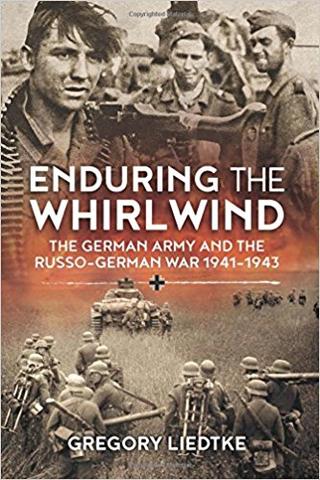Enduring The Whirlwind

Gregory Liedtke's Enduring The Whirlwind is more than anything else a deep dive into the statistics behind the first two years of the war fought between Nazi Germany and the Soviet Union. Most importantly, Liedtke's work seeks to address the ongoing controversy over whether or not the numbers game played the key role in explaining the Ostheer's defeat at the hands of the Red Army. To do that, the author focuses the book on German personnel and material losses during the war's early years, and then looks at whether or not the Third Reich was capable of replacing those losses.
Enduring the Whirlwind is organized into six chapters covering the Wehrmacht's genesis, first year at war, Barbarossa prep, Barbarossa itself, rebuilding the Ostheer early in 1941, events during Operation Blue, and the recovery period following the Ostheer's defeat at Stalingrad. Each chapter is followed by an extensive set of appendices. The chapters also feature a number of maps (fourteen in total within the book's pages) which are clear, easty to follow, and germane to the corresponding text. In addition, each chapter is followed by a large number of tables, which along with the text and voluminous footnotes provides a wealth of statistical data on the Ostheer's staffing, armament, and replacement figures for select time periods during the war. In most instances the data presented is broken down by Army Group (with the German campaign in the Soviet Union initially featuring three primary army groups named north, center, and south).
The sheer amount of data presented is at times breathtaking. This is not a book for beginners. This work is for those with a healthy understanding of the war and a willingness to engage with voluminous amounts of information. In many ways, it can be considered a condensed guide to archival and published material from a plethora of sources. I would say that perhaps Enduring the Whirlwind could have been further broken down into additional chapters in order to make it a bit more digestible for the casual enthusiast of the Second World War's Eastern Front. However, on the other hand the author makes no bones about the fact that this is an academic work - and thus again the reader is forewarned.
I appreciate Liedtke's enormous research effort producing Enduring the Whirlwind. The book also provides evidence that helps counter the argument the Ostheer had shot it's bolt by August of 1941 or the end of Operation Typhoon at the latest. In fact, it provides ample evidence to the contrary - that poor German decision making regarding the allocation of resources (that as existed could have been used to accomplish much of the Third Reich's heinous goals for Eastern Europe) proved one of the key reasons for Nazi Germany's failures. That said, and given the author's focus on assessing the state of the Ostheer's "military strength" I wish he would have spent more time at least acknowledging other important factors in explaining "military strength": such as command and control, training, leadership, doctrine, communications, intelligence, or logistics to name a few.
For example, take logistics. It is clear that Liedtke is aware of the logistical deficiencies undermining the Ostheer's effort in the Soviet Union. There are several discussions of rail and trucking issues that are much appreciated. More time not only there, but also in terms of looking at the component combat arms modes of transportation and break down thereof would have bolstered the author's arguments. For instance, at many times he indicates that the panzer divisions were in a much stronger state even late in Barbarossa than previously credited and does so by focusing on the numbers of operational tanks. Nevertheless, were the petrol, oil, and lubricants available in sufficent quantity to allow these divisions to fight and move as need be? What was the state of each panzer or motorized division's truck park at various points during the campaign? Did the infantry divisions retain the prime movers needed to make sure their heavy weapons could be effectively deployed?
Those question are never really answered. And yes, I know that the author is clear that this work is an attempt to redress the argument that Germany lost against the Red Army because of the numbers game - i.e. that the German army was overwhelmed by the Red Army's hordes. To wit, the introduction plainly states that "The primary goal of this study is to address the perception of numerical-weakness in terms of Germany's ability to replace its losses and regenerate its military strength, and assess just how accurate this argument was during the first half of the Russo-German War (June 1941 - June 1943)." (page xxii of the Introduction) In that regard, I would say that the author succeeded - but only in part. That said, even if the book is not perfect in terms of advancing Liedtke's conclusion that "Germany was actually able to regenerate its forces to a remarkable degree with a steady flow of fresh men and equipment, and German field divisions on the Eastern Front were usually far stronger than the accepted narrative of the war would have one believe" (page xxiii of the Introduction) this reviewer finds that the author walks the reader a significant part of the way there.
I recommend this book to my readers as a reference source more than anything else. It is good at detailing the strength and regenerative work done by the Wehrmacht at various points leading up to and early in the war. In terms of fleshing out those numbers and providing the meaty analysis that would really answer whether or not the Ostheer was effectively regenerating its "military strength" I would say if falls short. Nevertheless, if you are interested in the numbers (especially in terms of losses and replacements regarding both men and machines) underlying the fighting on Germany's Eastern Front during the Second World War then there is much to enjoy in this book.



Post new comment